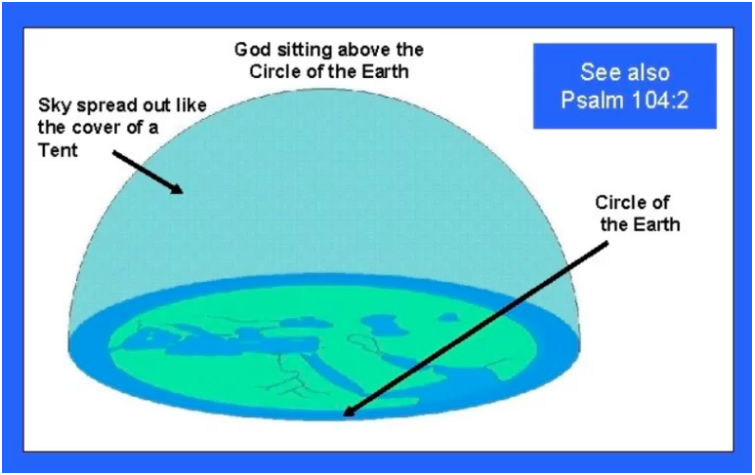|
This is a non-WLC article. When using resources from outside authors, we only publish the content that is 100% in harmony with the Bible and WLC current biblical beliefs. So such articles can be treated as if coming directly from WLC. We have been greatly blessed by the ministry of many servants of Yahuwah. But we do not advise our members to explore other works by these authors. Such works, we have excluded from publications because they contain errors. Sadly, we have yet to find a ministry that is error-free. If you are shocked by some non-WLC published content [articles/episodes], keep in mind Proverbs 4:18. Our understanding of His truth is evolving, as more light is shed on our pathway. We cherish truth more than life, and seek it wherever it may be found. |

Before becoming convinced that Genesis Chapter One accurately accounts for creation and the cosmos, I did not know quite what to think about what the Bible calls the firmament. I didn’t have to consider it much since most modern translations render the Hebrew word raqia rather innocuously as sky or expanse.
The KJV and NKJV translate “raqia” properly as the firmament, a word that communicates something of its true nature—an immense and firm vaulted dome-like structure made of crystal or very strong glass.
Those who claim that they have been to “outer space” and observed first-hand the suspended spherical earth often use the word “fragile” to describe it. I believe this is by design to conjure fear for our continued existence, which is all part of Satan’s grand scheme of deception. Those who do Satan’s bidding do not want us to know that we are safely enclosed in the firmament and watched over by our Creator.
He is the one who sits above the circle of the earth, and its inhabitants are like grasshoppers; the one who stretches out the heavens like a veil and spreads them out like a tent to live in, Isaiah 40:22 (LEB)

The mention of Yahuwah’s creating the firmament in Genesis Chapter One confronts us with an unavoidable choice. Will we believe what the Bible says or what atheistic astrophysicists and lying NASA tell us?
Did Yahuwah say that the firmament is a very real structure above the earth where the sun, moon, and stars are located? Will we choose to believe Yahuwah or that there is no such structure, thus relegating the Bible to an archaic fable that cannot be relied upon when it comes to science?
Unfortunately, at this point, many of us have unwittingly put more faith in a satanic lie than in Yahuwah’s Word.
Now, let’s return to our study of the firmament. Translators’ bias is a very real thing and happens when those who translate the Scripture deliberately or inadvertently impose their views and understanding upon the Word of Yahuwah. The less literal the translation, the more likely we will encounter this.
We all bring our ingrained ways of viewing our world and reality to our study of the Bible. This is difficult to overcome, but students of the Bible are charged with allowing the Bible to say what it means (exegesis) instead of what we would like for it to say (eisigesis).
The Hebrew word for firmament is raqia, which literally means something hard like beaten out metal. In Genesis 1:8, Yahuwah called the firmament (raqia) heaven (shamayim). Yahuwah used the firmament to separate the waters (mayim) below from those located above it.
Thus Elohim made the firmament, and divided the waters which were under the firmament from the waters which were above the firmament; and it was so. Genesis 1:7 (NKJV)
So, above the firmament there was and currently is (Psalm 148:4) water. The shamayim (heavens) contain mayim (waters). The waters above did not disappear after the flood. Psalm 148:1 dispenses with this error.
Therefore, the firmament must be hard and strong enough to support the enormous weight of untold amounts of water which are above it, some of which apparently were released upon the earth in judgment during the great flood. (Genesis 7:11-12)
There is no reason to suppose that those waters were not replaced. In fact, there appears to be a giant system of water above and below the earth, which ancient Hebrews believed looked something like the below image.

Sadly, the translators of my beloved New Living Translation, in their attempt to explain difficult concepts in modern language and terms, took the liberty to translate mayim as “water vapor.” Often they do a good job of translating idea for idea, especially when it comes to helping us understand theological terms such as justification, but in this case they did us a great disservice. Mayim means waters or a flood, not vapor.
Almost all translators choose words for raqia (firmament) that are more palatable to our modern “scientific” heliocentric worldview pounded into us by our education system and media. Check it out for yourselves. The NASB, ESV, and NET, my usual “go to” versions for a literal rendering of the Bible, all use the word “expanse,” which communicates absolutely nothing of the hard and strong nature of the firmament, but provides the heliocentrist with complete liberty to superimpose that view, complete with unlimited expanses of “outer space,” upon the Scripture. The KJV and NKJV are faithful to the Hebrew and use the word “firmament” to communicate its solidity and strength.
Can you, with Him, spread out the skies, Strong as a molten mirror? Job 37:18 (NASB95)
So, which do we choose? Do we believe the Genesis account of creation is scientifically accurate and go with the more literal rendering of raqia, or do we accommodate Scripture to our scientific bias by watering down what the Bible says? Unfortunately, many Bible believers have done the latter based on NASA’s testimony. Imagine taking the word of an agency known to lie over Yahuwah, who cannot lie.
As for me, when I stand before Yahuwah one day, I would prefer that he tells me I took him too literally rather than have him question why I altered his words.
Yahushua replied, “Your mistake is that you don’t know the Scriptures, and you don’t know the power of Yahuwah. Matthew 22:29 (NLT)
Isaiah gives us a glimpse of Yahuwah’s position above the firmament, gazing down upon the “circle” of the earth.
It is He who sits above the circle of the earth, And its inhabitants are like grasshoppers, Who stretches out the heavens like a curtain, And spreads them out like a tent to dwell in. Isaiah 40:22 (NKJV)
Those who insist that the earth is a globe sometimes refer to the above verse as a “proof text.” The word translated “circle” means drawn as a circle, as one would form using a compass.
The word “ball” is used in Isaiah 22:18; so, the prophet knew the difference between a circle and a ball. The image below could be thought of as a circle with edges as would be formed by pressing a circular seal into wax, which was a word picture used in Job 38:14, when Yahuwah himself is talking about his creation.

It is changed like clay under a seal... Job 38:14a (LEB)
Going back to the verse from Isaiah above, the heavens (which was the name given to the firmament) are stretched out like a curtain and spread out like a tent. The most likely kind of tent would be a circular dome-like tent, similar to a yurt.
Amos 9:6 in the NASB provides us with wonderful picture of the firmament.
The One who builds His upper chambers in the heavens And has founded His vaulted dome over the earth, He who calls for the waters of the sea And pours them out on the face of the earth, Yahuwah is His name. Amos 9:6 (NASB95)
Yahuwah placed his throne and “upper chambers” above the firmament.
The Hebrew word for “vaulted dome” is aguddah, which is used in Jeremiah 37:16 to describe the vaulted dungeon cell in which the prophet was held. For some reason, the NASB translators are the only ones that chose to use aguddah in the verse from Amos to describe the firmament as a vaulted dome above the earth. I believe this is another clear example of translators’ bias. On the positive side, the other versions make the connection that the upper “strata” (NKJV) is attached to the earth. Putting it together, we understand the vaulted dome of the firmament is attached firmly to the earth.
Bless Yahuwah, O my soul! O Yahuwah my God, You are very great: You are clothed with honor and majesty, 2 Who cover Yourself with light as with a garment, Who stretch out the heavens like a curtain. 3 He lays the beams of His upper chambers in the waters, Who makes the clouds His chariot, Who walks on the wings of the wind, 4 Who makes His angels spirits, His ministers a flame of fire. 5 You who laid the foundations of the earth, So that it should not be moved forever, Psalm 104:1–5 (NKJV)
Those who hold that the earth is a stationary plane believe the firmament extends beyond the ring of ice that contains the oceans, falsely depicted as the continent of Antarctica on the globe. Interestingly, a page from the Encyclopedia Americana (1958 edition) references the existence of the firmament in that area of the earth. Click here to see a video on YouTube.
The firmament is an extremely vast structure that extends over an currently unknown area of the flat earth up to an unknown altitude.
As the heavens for height and the earth for depth, So the heart of kings is unsearchable. Proverbs 25:3 (NKJV)
Based on interesting video evidence, some think it may be about 73 miles high. Two videos below show a rocket launch that suddenly stops at 73 miles up. The other shows lightning sprites at about the same altitude, illuminating what appears to be the firmament above them. I cannot personally vouch for the authenticity of either video, but they are easily found on YouTube and are generally recognized as genuine. Regardless, these are not “proofs,” only evidence. The “proof” is Yahuwah’s Word.
The first video just above shows the sun and moon simultaneously above the flat earth. It is obvious that the rocket has a fish-eye lens because the earth appears convex or concave depending on the camera's attitude. The Bible says that Yahuwah placed the sun, moon, and stars in the firmament on Day Four of creation.
Then Elohim said, “Let there be lights in the firmament of the heavens to divide the day from the night; and let them be for signs and seasons, and for days and years; 15 and let them be for lights in the firmament of the heavens to give light on the earth”; and it was so. 16 Then Elohim made two great lights: the greater light to rule the day, and the lesser light to rule the night. He made the stars also. 17 Elohim set them in the firmament of the heavens to give light on the earth, 18 and to rule over the day and over the night, and to divide the light from the darkness. And Elohim saw that it was good. 19 So the evening and the morning were the fourth day. Genesis 1:14–19 (NKJV)
This passage completely exposes the error of heliocentrism, which derives from the Big Bang evolutionary theory of forming the “ever-expanding” universe. The earth and seas with the vaulted dome of the firmament were firmly in place before the lights were placed in the firmament. Several important points need to be made. First, the sun runs a circuit over the stationary plane of the earth. (Psalm 19:6) Both the sun and moon are lights. The moon is not a reflector, which is proved by examining its light compared to the sun’s.
The stars are luminaries in the firmament, not distant suns.
The firmament contains everything that NASA and modern astrophysics tell us is located in what they call “outer space.” The Bible only refers to outer darkness, where the disobedient will go after the judgment. Outer space is a fiction. As viewed through instruments like the Hubble telescope, everything that NASA claims is in outer space are CGI images created from “data.” The planets, galaxies, etc., do not exist as NASA claims.
Belief in the literal firmament is a massive key to understanding the world in which we live.
When we dismiss the biblical firmament, it opens us to false cosmologies introducing foreign ideas contradicting Yahuwah’s Word. I encourage you to think long and hard about the firmament. I have only scratched the surface. Humanity does not know a great deal about this magnificent and mysterious structure. But Yahuwah wants to reveal more to us; I am firmly convinced because it reveals his handiwork. (Psalm 19:1)

This is a non-WLC article by by Pete Beck III.
We have taken out from the original article all pagan names and titles of the Father and Son, and have replaced them with the original given names. Furthermore, we have restored in the Scriptures quoted the names of the Father and Son, as they were originally written by the inspired authors of the Bible. -WLC Team







